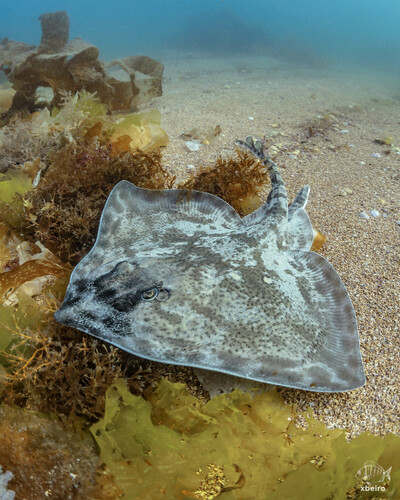
Thornback Ray
The Bluefin Tuna, a majestic and powerful fish, is a marvel of the ocean. Known for its incredible speed, size, and migratory journeys, it plays a critical role in marine ecosystems. However, its high value in the culinary world has placed immense pressure on its populations, making it a focal point of conservation efforts.
5 15 years
Lifespan
100 - 120 cm
Length
Near Threatened
Conservation Status
20 km/h
Swimming speed
Carnivorous
Diet
Local Migration
Migration
Appearance Overview
The Bluefin Tuna is renowned for its large, streamlined body, built for speed and endurance.
Color
Dark metallic blue on top, with a silvery-white underside
Fins
Two dorsal fins, the first depressible into a groove; small, yellow finlets run down the back and belly
Body Shape
Torpedo-like, designed for efficient swimming
Length
Up to 13 feet (4 meters), commonly around 6.5 feet (2 meters)
Weight
Up to 2,000 lbs (907 kg), commonly around 550 lbs (250 kg)
Diet
Carnivorous, feeding on a variety of fish, squid, eels, and crustaceans.
Feeding Behavior
Highly active predators, Bluefin Tuna use their speed and agility to hunt. They often hunt cooperatively, herding and trapping smaller fish.
Social Behavior
Forms large schools, especially during spawning season. They are highly migratory, traveling long distances across oceans.
Commercial Relevance
Extremely high value, particularly in sushi and sashimi markets, where it is considered a delicacy. This demand drives high prices and intensive fishing efforts.
Conservation measures
Efforts include fishing quotas, seasonal closures, minimum size limits, and international agreements to manage stocks. Some organizations are working on sustainable aquaculture practices.
Status
Atlantic Bluefin Tuna: Endangered; Southern Bluefin Tuna: Critically Endangered; Pacific Bluefin Tuna: Vulnerable
Threats
Overfishing is the primary threat. High demand for Bluefin Tuna in the sushi market has led to significant population declines. Other threats include bycatch and illegal fishing.
Habitat Distribution
Depth Range
0-3,300 feet (0-1,000 meters), though they are most commonly found in shallower waters.
Geographic Range
Atlantic Ocean (Eastern and Western), Mediterranean Sea, Pacific Ocean (Northern and Southern)
Preferred Environment
Temperate and subtropical waters; open ocean (pelagic) environments, often near continental shelves and slopes.
Reproduction and Life Cycle
Breeding Habits
Spawns in warm waters, with major spawning grounds in the Gulf of Mexico and the Mediterranean Sea. Spawning typically occurs in spring and summer.
Development Stages
Eggs hatch into larvae, which are planktonic. They grow rapidly, undergoing several developmental stages before reaching maturity. Juveniles often form schools.
Fecundity
Females can produce a large number of eggs, up to 30 million per season, depending on their size and age.
Maturity Age
Atlantic Bluefin Tuna: 4-8 years; Southern Bluefin Tuna: 8-12 years; Pacific Bluefin Tuna: 3-5 years
Faqs about Thornback Ray
Where are Bluefin Tuna found?
Bluefin Tuna are highly migratory, with some populations crossing entire oceans. They are found in both the Atlantic and Pacific Oceans, as well as the Mediterranean Sea.
Why are Bluefin Tuna endangered?
Overfishing is the biggest threat. The high demand for Bluefin Tuna, especially in sushi, has led to severe population declines.
How fast can Bluefin Tuna swim?
Bluefin Tuna are among the fastest fish in the ocean, capable of bursts of speed up to 43 mph (70 km/h).
Are Bluefin Tuna warm-blooded?
Bluefin tuna are warm-blooded, which is rare among fish. This allows them to maintain a higher body temperature than the surrounding water, aiding in muscle efficiency during long migrations and dives.
Can I eat Bluefin Tuna?
Yes, but it's crucial to choose Bluefin Tuna from sustainable sources, if available. Check seafood guides and certifications to make informed choices.
How deep can Bluefin Tuna dive?
They can dive to depths of over 3,000 feet (900 meters) in search of food.
How long do Bluefin Tuna live?
Bluefin Tuna can live for up to 40 years, though this varies by species and location.
Copyright @ Nature Style Limited. All Rights Reserved.
 English
English